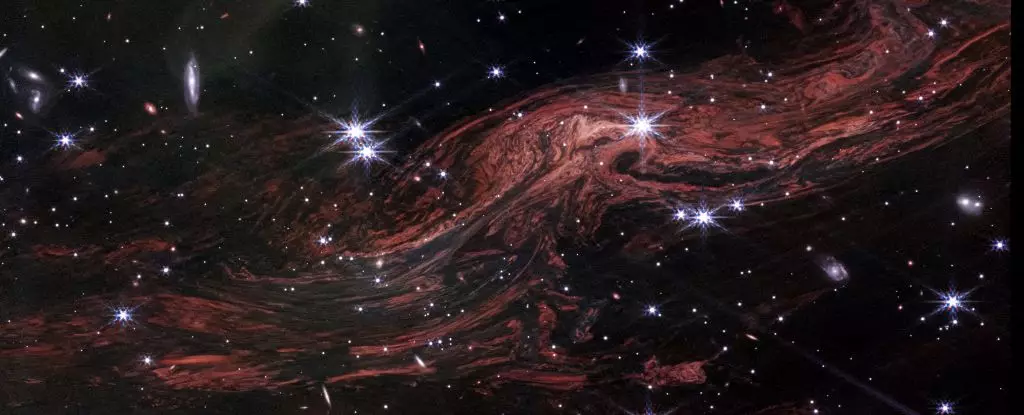Recent advancements in astronomical imaging, particularly those from the James Webb Space Telescope (JWST), have unveiled the intricate structures of dust drifting within our universe with stunning clarity. For years, the interstellar medium—the matter that occupies the vast expanses between stars—has remained somewhat mysterious, especially in terms of its flow and turbulence. However, with the recent images capturing the aftermath of the Cassiopeia A supernova, astronomers are gaining unprecedented insights into the dynamics of this elusive cosmic fabric.
The explosion of Cassiopeia A, observed on Earth in the late 17th century, now serves as a lens through which scientists can observe the aftermath of cosmic events. As the light from this supernova expanded, it interacted with nearby dust clouds, warming and illuminating them to produce a faint red glow. The JWST’s remarkable ability to detect these subtle, red wavelengths has revealed a complex structure that had previously eluded astronomers, allowing them to peer into the interstellar medium’s inner workings.
One of the key phenomena that have emerged from JWST’s observations is the concept of light echoes. Light echoes occur when a burst of radiation encounters obstacles, such as cosmic dust clouds, which reflect the light. This results in a delayed reception of the light, creating echoes much like the reverberations of sound in a large space. By studying light echoes, researchers can map the arrangements and characteristics of the interstellar medium.
Historically, light echoes have primarily been associated with bright astronomical events or thick clouds of dust located close to the source of light. V838 Monocerotis is one example where scientists have successfully captured such phenomena. However, it’s the more tenuous dust that lies further away from light sources that has posed challenges to investigation—until now. JWST’s infrared capabilities have enabled astronomers to explore regions of space they couldn’t have accessed before, including the wisps of dust near Cassiopeia A.
Revolutionary Discoveries in Cosmic Structure
The findings from JWST have fundamentally changed our understanding of dust clouds and their composition. The telescope has captured detailed imagery of structures within the dust, revealing them to be akin to layers of an onion, as described by astronomer Josh Peek from the Space Telescope Science Institute. These layers consist of dense sheets of materials interspersed with intricate knots and whorls that resemble tree rings, providing a wealth of information about the nature and configuration of dust throughout the cosmos.
What stands out about these observations is the spatial resolution JWST offers. With the ability to discern features down to approximately 400 astronomical units—far smaller than any previous instruments could achieve—scientists are now able to explore the micro-architecture of the interstellar medium. The existence of these detailed structures suggests a connection to magnetic fields traversing through space, indicating that the organization of this cosmic material is influenced by magnetic turbulence.
A New Era of Research
The implications of these discoveries extend far beyond mere observation; they represent a paradigm shift in how we study the universe. As astronomer Armin Rest aptly puts it, JWST’s observations are akin to conducting a CT scan of the interstellar medium. By collecting multiple “slices” of data over time, researchers can construct a three-dimensional model of these structures, enabling a deeper understanding of the dynamic processes at work.
This transformative approach allows us not only to observe the complexity of the interstellar medium but also to infer how these structures evolve over time. As light and matter interact, they provide clues about the lifecycle of cosmic dust, the influence of magnetic fields, and the broader dynamics of star formation—all of which are crucial for painting a comprehensive picture of our universe.
As researchers delve deeper into the data collected from JWST, we can anticipate a wave of new studies and findings that will elucidate the interstellar medium’s role in the grand scheme of the universe. The excitement sparked by the presentations at the 245th Meeting of the American Astronomical Society only hints at the wealth of knowledge that JWST will help unlock in the coming months and years.
The revelations made possible by JWST highlight a crucial era in astrophysics—one where we can finally begin to see the unseen and understand the complexities of the cosmos in greater detail. This progress not only enhances our comprehension of dust in the universe but also enriches our broader understanding of the forces that have shaped the stars and the galaxies they inhabit. The universe has many more secrets to unveil, and with advanced technology like JWST, our quest for knowledge continues to evolve.

